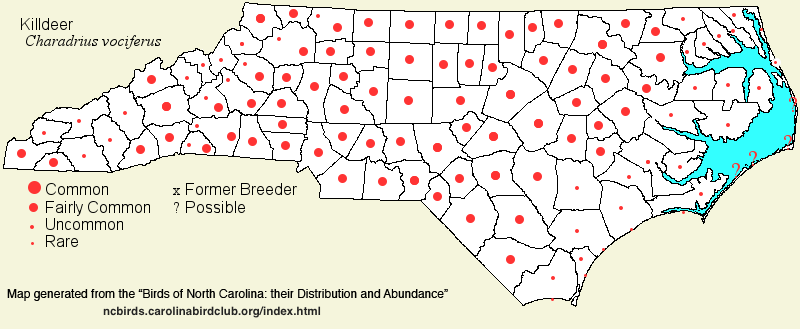 |  |
|
Killdeer - Charadrius vociferus CHARADRIIDAE Members: | Search Common: Search Scientific: |
|
|
|||||||
| General Comments | Over most of the state, the Killdeer is the most familiar and often seen shorebird, it being found in every county over most of the year. Its noisy calls attract attention, and it often seems to be the sentinel species where flocks of shorebirds gather inland, such as at mudflats on large reservoirs. Despite the species nesting on the ground in open habitats, where nests can be easily disturbed by man or his pets, or by predators, the species seems to be maintaining its numbers, if not slightly increasing. Killdeers nest on the ground amid gravel or pebbles, or at times on gravel rooftops. These places are in open, disturbed areas, such as around lake or pond margins, dirt/gravel roads, and vacant lots, even in cities. They forage on lawns, pastures, mudflats, plowed fields, and shorelines, both in dry areas and in wetlands. For example, they are by far the most common shorebird on mudflats of reservoirs in the summer and fall. They tend to avoid salt or brackish water, but do occur near the coast but in freshwater areas or in short-grass or gravelly habitats. | ||||||
| Breeding Status | Breeder | ||||||
| NC BRC List | Definitive | ||||||
| State Status | |||||||
| U.S. Status | |||||||
| State Rank | S5B,S5N | ||||||
| Global Rank | G5 | ||||||
| Coastal Plain | Breeding permanent resident, with migratory movements. Along the coast, mostly uncommon as a breeder, but fairly common, at least locally, at other seasons; farther inland, both in Tidewater and away from tidal areas, it is fairly common as a breeder, and generally common in fall and winter, as numbers in the state are enhanced by migrants from farther north. Peak counts: 650, Beaufort, 4 Dec 2023. | ||||||
| Piedmont | Breeding permanent resident, with migratory movements; increasing, at least slowly. Fairly common in the breeding season (mainly Mar thru Jun), and common in the remainder of the year, with numbers peaking in the fall. Peak counts: | ||||||
| Mountains | Breeding permanent resident, with migratory movements. Fairly common in the breeding season, at least in the lower and middle elevations (below about 4,000 feet); fairly common in migration, but mostly uncommon in winter, though it can be fairly common in some open valleys. Unlike downstate, the species is less common in winter than in summer. Peak count: 400, Hooper Lane (Henderson), 28 Feb 2014. | ||||||
| Finding Tips |
This widespread species should not be hard to find around ponds, extensive lawns, or large plowed fields. *** to **** | ||||||
| Attribution | LeGrand[2024-05-09], LeGrand[2023-03-10], LeGrand[2014-08-12] | ||||||
| NC Map Map depicts all counties with a report (transient or resident) for the species. | Click on county for list of all known species. |
| NC Breeding Season Map Map depicts assumed breeding season abundance for the species. |  |